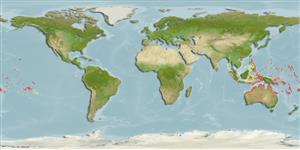>
Gobiiformes (Gobies) >
Gobiidae (Gobies) > Gobiinae
Etymology: Eviota: No etymology given, suggested by Christopher Scharpt: from Latin 'eu' for 'true' and 'iota' for anything very small, in combination 'truly very small' referring to it as being the smallest vertebrate at the time it has benn described by Jenkins (thus, making the suggestion by Scharpt plausible.
Eponymy: Afele was a Samoan boy who collected the holotype from coral heads in Pago Pago. Nothing more was recorded about him. (Ref. 128868), visit book page.
More on authors: Jordan & Seale.
Environment: milieu / climate zone / depth range / distribution range
Ecologia
marinhas associadas(os) a recifes; intervalo de profundidade 0 - 3 m (Ref. 107299). Tropical; 20°N - 24°S
Pacific Ocean: Ryukyu Islands, Japan; south to Timor Sea and the Great Barrier Reef; east to Oceania and Tuamotus.
Tamanho / Peso / Idade
Maturity: Lm ? range ? - ? cm
Max length : 1.8 cm SL macho/indeterminado; (Ref. 1602)
Descrição suscinta
Chaves de identificação | Morfologia | Morfometria
Espinhos dorsais (total) : 7; Raios dorsais (total) : 8 - 9; Espinhos anais: 1; Raios anais : 6 - 8. This species is distinguished by the following characters: cephalic sensory-canal pore system lacking only the IT pore (pattern 2); branched pectoral-fin rays; dorsal/anal-fin formula is 9/8; the fifth pelvic-fin is ray small or rudimentary (about 10% of 4th pelvic ray); caudal fin has rows of small dark spots set close together on rays, membranes dark; presence of a small dark spot over preural centrum associated with last subcutaneous bar may be present; the scale edges are not dark (Ref. 107299).
Occurs on algal mats of shallow exposed reefs.
Ciclo de vida ou comportamento de acasalamento
Maturidade | Reprodução | Desova | Ovos | Fecundidade | Larvas
Benthic spawner.
Myers, R.F., 1991. Micronesian reef fishes. Second Ed. Coral Graphics, Barrigada, Guam. 298 p. (Ref. 1602)
Status na Lista Vermelha da UICN (Ref. 130435: Version 2024-1)
Ameaça para os humanos
Harmless
Uso pelos humanos
Ferramentas
Relatórios especiais
Baixar XML
Fontes da internet
Estimates based on models
Preferred temperature (Ref.
123201): 24.8 - 28.9, mean 27.5 °C (based on 364 cells).
Índice de diversidade filogenética (Ref.
82804): PD
50 = 0.5000 [Uniqueness, from 0.5 = low to 2.0 = high].
Bayesian length-weight: a=0.00692 (0.00284 - 0.01683), b=3.10 (2.92 - 3.28), in cm total length, based on LWR estimates for this Genus-body shape (Ref.
93245).
Nível Trófico (Ref.
69278): 3.0 ±0.3 se; based on size and trophs of closest relatives
Resiliência (Ref.
120179): Elevada, tempo mínimo de duplicação da população menor que 15 meses (Preliminary K or Fecundity.).
Fishing Vulnerability (Ref.
59153): Low vulnerability (10 of 100).
Nutrients (Ref.
124155): Calcium = 624 [246, 2,501] mg/100g; Iron = 2.13 [0.77, 5.38] mg/100g; Protein = 17.6 [15.4, 19.6] %; Omega3 = 0.0851 [, ] g/100g; Selenium = 27.4 [5.8, 108.0] μg/100g; VitaminA = 100 [15, 677] μg/100g; Zinc = 6.37 [3.02, 11.93] mg/100g (wet weight);
